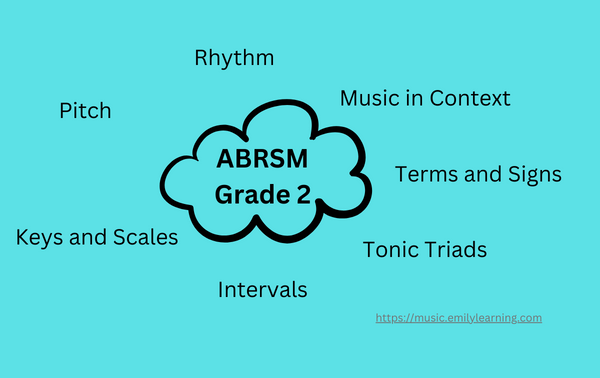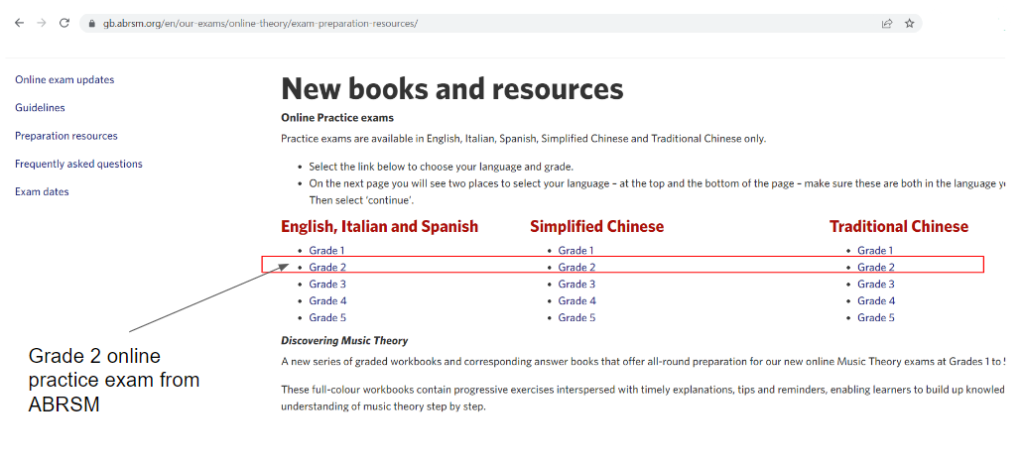In this post, let’s look at the format of the ABRSM Grade 2 Online Music Theory Exam in detail.
Seven sections of the ABRSM Grade 2 Online Music Theory exam
There are seven sections in the ABRSM grade 2 online music theory exam. They are:
Each section has a specific music theory concepts tested.

Marks and Passing Criteria for ABRSM Grade 2 Online Music Theory Exam
The seven sections of the ABRSM Grade 2 online music theory exam are worth 75 marks in total. To pass, students will need to score 50 out of 75.
Here are the criteria:
50 – 59: Pass
60- 64: Merit
65 and above: Distinction
Duration of the ABRSM Grade 2 Online Music Theory exam
The total duration of the exam is 90 minutes.
Section 1: Rhythm
Section 1 is a 15 marks section on rhythm. It is then divided into section 1.1 to 1.6.
Section 1.1: Time Signature
Section 1.1 consists of 3 questions. Hence, this section is worth 3 marks. In each question, you’ll need to determine the time signature for a bar of music written.
Section 1.2: Bar line
Section 1.2 consists of 5 questions. Hence, this section is worth 5 marks. Like question 1.1, this question is on time signatures, and students would need to put the bar line at the correct position.
Section 1.3: Note value
Section 1.3 consists of 2 questions. This section is worth 2 marks. The questions here test students on their knowledge of note values.
Section 1.4: Grouping of notes
Section 1.4 consists of 1 question, and is worth 1 mark. Here, students are given 3 choices, and they are to select one where the notes are grouped correctly.
Section 1.5: Rests
Section 1.4 consists of 3 questions, and is worth 3 marks. Here, students are asked to determine whether the rests are correct. There are two things to check for in this section: whether the time value of the rest is correct, and whether the rest is grouped correctly.
Section 1.6: Double or half the note value
Section 1.6 in the Grade 2 ABRSM theory exam is different from the same section of Grade 1. In Grade 2, Section 1.6 consists of a single question. Here, students are asked to rewrite a melody at twice or half its note value.
Section 2: Pitch
Section 2 is a 15 marks section.
In the pitch section, students are expected to be able to read notes on the music stave in treble and bass clef, and compare pitches (which pitch is higher or lower).
There are 4 parts in section 2, 2.1 to 2.4.
Section 2.1: Determine the name of each note
Section 2.1. consists of 6 questions and is worth 6 marks. In this section, students are asked to determine the correct name of each note.
Section 2.2: Which clef is it
Section 2.2. consists of 2 questions and is worth 2 marks. In this section, students are given a note on the music stave (without a clef). Then they are asked what clef it should be (either treble or bass clef), so that it is a certain note.
Section 2.3: Same note on different clefs
Section 2.3. consists of 4 questions and is worth 4 marks. In this section, students are to rewrite the notes in the new clefs (treble or bass clef), keeping the pitch the same.
Section 2.4: Questions on pitch
Section 2.4 consists of 3 questions, and is worth 3 marks. Students are given statements on pitch, and they need to determine whether each statement is true or false.
Section 3: Keys and Scales
Section 3 is on keys and scales and is worth 15 marks. Section 3 is divided into 9 sections.
Section 3.1 and 3.2: Key signature
In section 3.1 and 3.2, students are asked to select the correct key signature for a given key. Section 3.1 and section 3.2 are worth 1 mark each.
Section 3.3: Accidentals
This section is worth 3 marks.
In section 3.3., students are given a piece of melody, and the key of the melody. They are then asked to determine which three notes in the melody require accidentals.
Section 3.4: What key is the melody
This section is worth 2 marks.
In this section, students are given a short melody, and asked to determine the key of the melody.
Section 3.5: True or False Question on Keys and Scales
Section 3.5 consists of 1 true or false question. This section is worth 1 marks. In this section, students are given a statement on keys and scales, and they are to determine whether the statement is true or false.
Section 3.6: Ascending or Descending Scale
Section 3.6 has a single question, and is worth 1 mark.
In section 3.6, students are given 3 choices, and they have to select the one is the correctly written scale for a given key.
Section 3.7: Semitone
This is a 2 mark question.
In section 3.7, a scale in a given key. Students are to find pairs of notes that are a semitone apart.
Section 3.8: Scales – spot the error
In section 3.8, students are given a scale in a given key. They are to look for 2 mistakes in the written scale.
Section 3.9: Fill in the missing note
In section 3.9, students are given a scale with 2 missing notes. They need to indicate what are the missing notes.
Section 4: Intervals
In grade 2, students are tested on the intervals between notes (in terms of numbers only). E.g. the notes are a 5th apart, etc. All the ten questions in the interval section are in section 4.1.
Section 4.1: Write a note to form a given interval.
Section 4.1 consists of 10 questions and is worth 10 marks.
For each question, you’ll be given a pair of notes, and you’ll be asked the interval between the notes.
Section 5: Tonic Triads
This section is worth 10 marks, and is subdivided into 3 sections, section 5.1 to 5.3.
Section 5.1: Determine whether a given chord is the correct tonic triad
Section 5.1 consists of 2 questions. In each questions, a key and a chord are given. Students are asked whether the chord is the tonic triad of the key.
Section 5.2: Form the tonic triad
Section 5.2 consists of 3 questions, and is worth 3 marks. In each question, students are given 2 out of the 3 notes of the tonic triad, and they are required to write the missing note of the tonic triad.
Section 5.3: Key of the tonic triad
Section 5.3 consists of 5 questions, and is worth 5 marks. In each question, students are given a chord, and they are to determine which key it belongs to.
Section 6: Terms and Signs
There are 5 questions in this section, and This section is worth 5 marks. In each question, students are given an Italian term or a music sign, and they are required to determine the correct meaning of each term/ sign.
Section 7: Music in Context
There are 5 questions in this section on music in context, and this section is worth 5 marks.
In this section, students are given a piece of melody (usually about 8 bars long), and they are asked questions pitch, tempo, dynamics, keys, chords, intervals, terms and signs and so on.
Digital Exam
The music theory exam is an online exam. Apart from knowing the concept, being familiar with how to answer the exam questions is also essential.
ABRSM provides a sample digital exam paper for each of their online theory exam. And I highly recommend my students to try them at least once before the actual exam.
The link to the grade 2 online practice exam can be found here.

